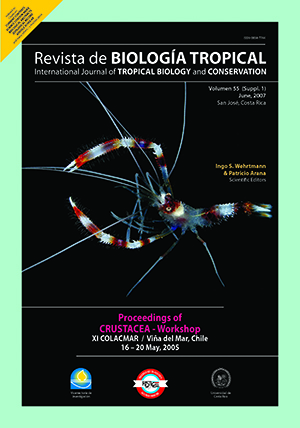Resumen
Sexual maturity, temporal reproductive pattern, and recruitment of juveniles were examined for the penaeoid shrimp Artemesia longinaris sampled for five and a half years in a tropical locality off the coast of São Paulo (23' S), Brazil. Monthly samples were taken from January 1998 to June 2003 at depths between 5 and 45 m. Ovarian maturity was used to examine breeding in adult females. Recruitment was defined as the percentage of juveniles of the total number of individuals in each month and season. A total of 10 288 females and 5 551 males were collected. Estimated sizes (carapace length) at the onset of sexual maturity were 11.0 mm and 13.4 mm for males and females, respectively. Over the five and a half years, females with ripe gonads were found in every season, with the highest percentages in summer (January-March). Juvenile shrimps occurred year-round. These results suggest a continuous reproduction of A. longinaris with temperature acting as an environmental stimulus for the duration of the ovary development cycle. These data and the hypothesis of the intrusion of the South Atlantic Central Water mass, which lowered water temperature and raised plankton production, suggest that the end of spring and the beginning of summer were the principal reproductive months. The classical paradigm of continuous reproduction at lower latitudes, with increased seasonality of breeding period at higher latitudes seems to apply to this species.##plugins.facebook.comentarios##

Esta obra está bajo una licencia internacional Creative Commons Atribución 4.0.
Derechos de autor 2007 Revista de Biología Tropical
Descargas
Los datos de descargas todavía no están disponibles.


